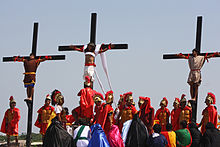Self-crucifixion

As a self-crucifixion refers to a special type of self-mortification , the practitioners on the model in Jesus to a cross pin or tie can be, the more penance to do and from the committed sins to clean. In the Philippines in particular , this form of mortification is still common today.
history
In contrast to self-mortification , which was quite common in the Middle Ages, self-crucifixions were neither recognized nor customary piety practice in the Christian West - a few exceptions were quickly seen as aberrations or "religious insanity". In 1848 Karl Wilhelm Ideler reported on two self-crucifixions carried out at the end of the 18th and beginning of the 19th century, describing the reactions of the respective environment, who react with incomprehension and interpret the crucifixion as "madness". According to Peter J. Bräunlein , the self-crucifixion, as we still find it today, was "invented" in 1962 in the Philippines. It developed through the idea of penance and flagellation , which got there through missionary orders and was received with enthusiasm.
Motifs
In addition to repentance for sins committed, which is the main motive for self-mortification as well as self-crucifixion, one finds another motivation in the desire for the imitatio Christi : Because Christ suffered for the sins on the cross, and thus the believers from eternal suffering after death that he had preserved through his painful crucifixion, one had to keep reminding oneself of his pain overcoming pain . In these cases, the motive is not a moral maxim , but rather a mnemonic principle : so that the sufferings of Christ are not forgotten, they should not only be understood spiritually, but also on one's own body.
distribution
Self-crucifixion is still practiced in the Philippines today: every year, during Holy Week, believers are crucified in the course of organized Passion Play. The Roman Catholic Church disapproves of this form of penance or remembrance of Christ.
literature
- Roland Borgards: Pain and Memory. Wilhelm Fink Verlag, Munich 2005, ISBN 3-7705-4067-0 , Google Books .
- Karl Wilhelm Ideler : Attempting a Theory of Religious Madness. Volume 1: The Apparitions of Religious Madness. Schwetschke and Son, Halle 1848, pp. 193-200, Google Books .
Web links
- science.orf.at - Article by Peter J. Bräunlein (lecturer in religious studies in Marburg)
Individual evidence
- ^ Karl Wilhelm Ideler: Attempt a theory of religious madness. Schwetschke and Son, 1848, pp. 193-200.
- ↑ Peter J. Bräunlein: Moving Images of the Passion: Philippine Passion rituals as 'image acts'. sciencev1.orf.at. Retrieved August 29, 2020.
- ↑ Roland Borgards: Pain and Memory. Wilhelm Fink Verlag, 2005, p. 69f.
- ^ Catholicculture.org